

Compact Muon Solenoid
LHC, CERN
| CMS-PAS-EXO-18-001 | ||
| Search for new particles decaying to a jet and an emerging jet | ||
| CMS Collaboration | ||
| June 2018 | ||
| Abstract: A search for events consistent with the pair production of a heavy mediator particle that decays to a light quark and a new fermion, called a dark quark, is performed using data corresponding to an integrated luminosity of 16.1 fb$^{-1}$ from proton-proton collisions at $\sqrt{s}= $ 13 TeV collected by the CMS experiment at the LHC in 2016. The dark quark is charged only under a new quantum chromodynamic-like force, and forms long-lived dark hadrons via a parton shower. The resulting emerging jet contains displaced vertices that are created by dark hadron decays to standard model hadrons. Mediator particles with masses between 400 and 1250 GeV are excluded for dark hadron decay lengths between 5 and 225 mm. This analysis is the first dedicated search for new particles that decay to a jet and this kind of emerging jet. | ||
|
Links:
CDS record (PDF) ;
inSPIRE record ;
CADI line (restricted) ;
These preliminary results are superseded in this paper, JHEP 02 (2019) 179. The superseded preliminary plots can be found here. |
||
| Figures & Tables | Summary | Additional Figures | References | CMS Publications |
|---|
| Figures | |

png pdf |
Figure 1:
Feynman diagrams for pair production of mediator particles, with mediator decay to a quark and a dark quark in the BSSW model via (left) gluon fusion and (right) quark-antiquark annihilation. |
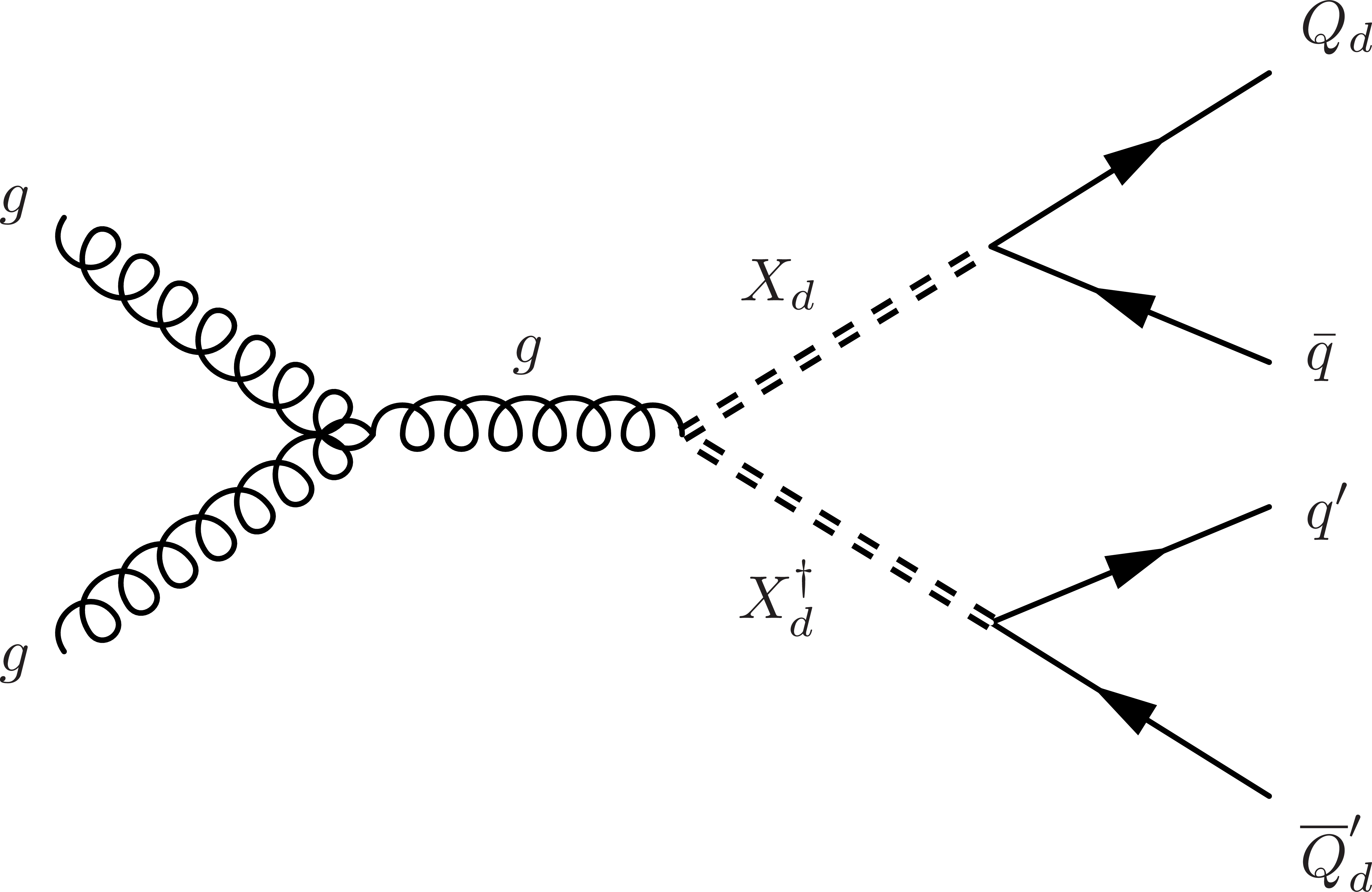
png pdf |
Figure 1-a:
Feynman diagrams for pair production of mediator particles, with mediator decay to a quark and a dark quark in the BSSW model via gluon fusion. |
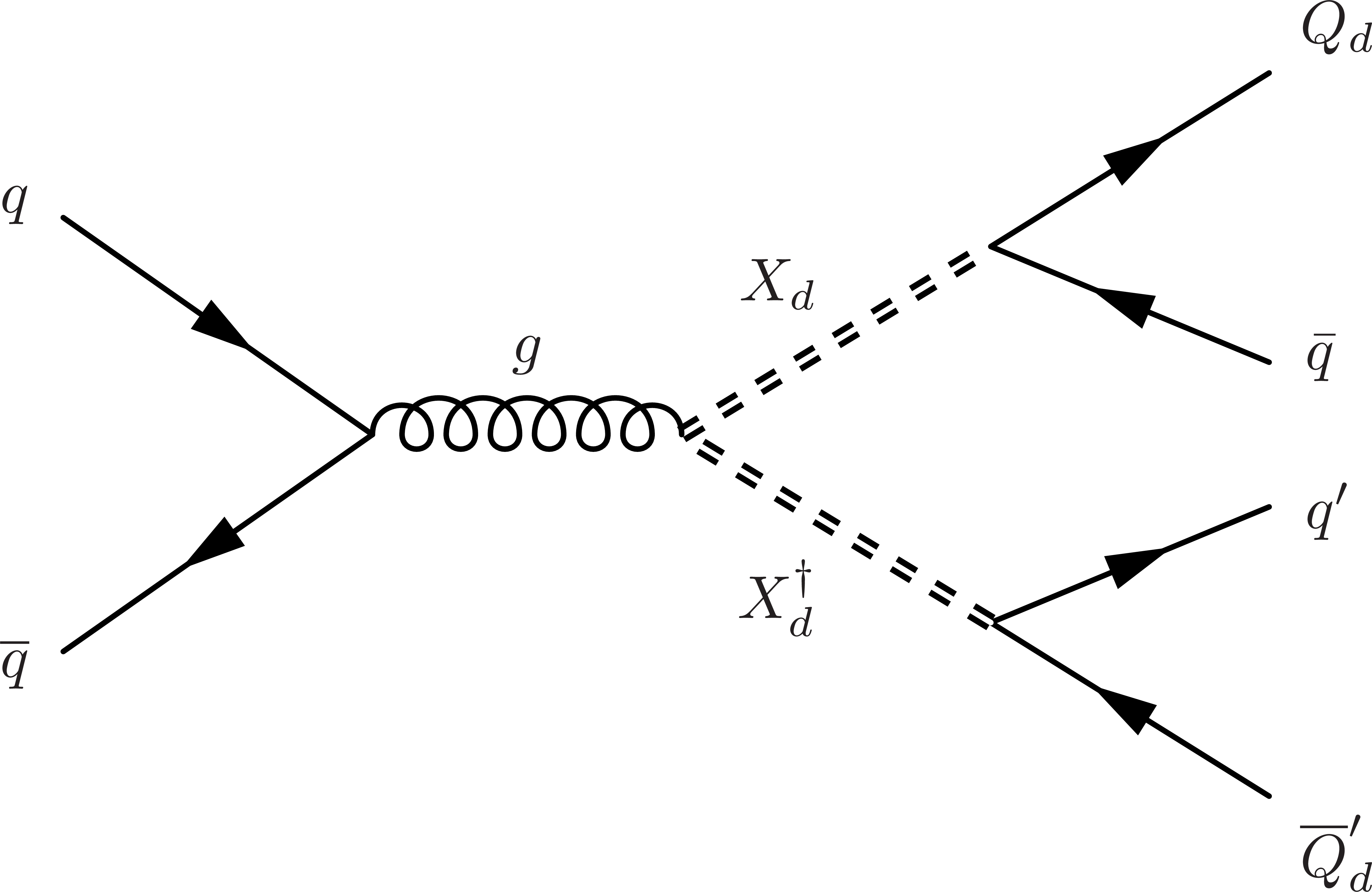
png pdf |
Figure 1-b:
Feynman diagrams for pair production of mediator particles, with mediator decay to a quark and a dark quark in the BSSW model via quark-antiquark annihilation. |
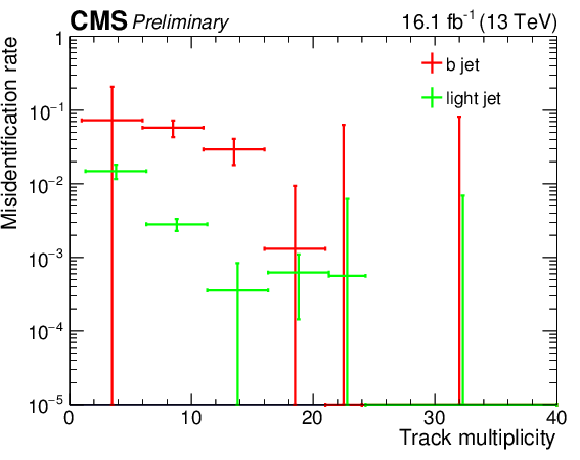
png pdf |
Figure 2:
Measured misidentification rate distribution as a function of track multiplicity for EMJ-1 defined in Table 2. The red one is for b jets while the green one is for light jets. |
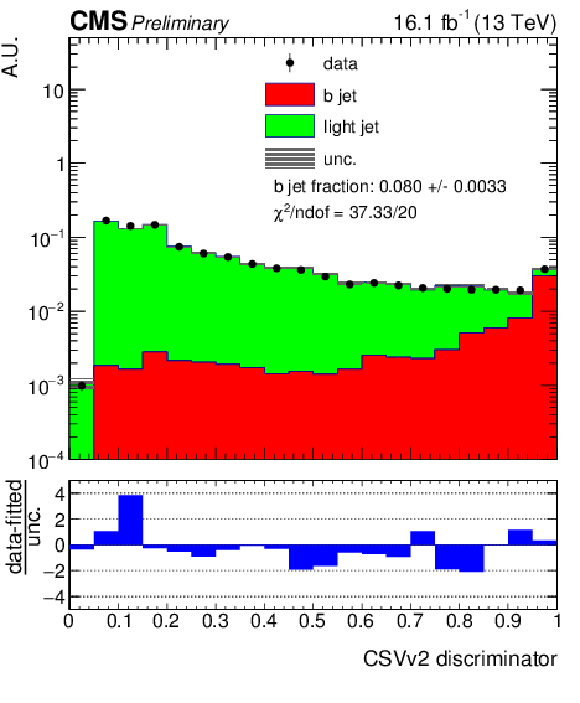
png pdf |
Figure 3:
Determination of b jet fraction by fitting the CSVv2 discriminator distribution. The red and green distributions are the CSVv2 discriminator templates of b jets and light jets, respectively. The black points with uncertainty bars show the distribution of the data. The bottom inset shows the difference between data and fitted result, divided by the statistical uncertainty. The distributions here come from kinematic samples of selection set 1 in Table 3. |
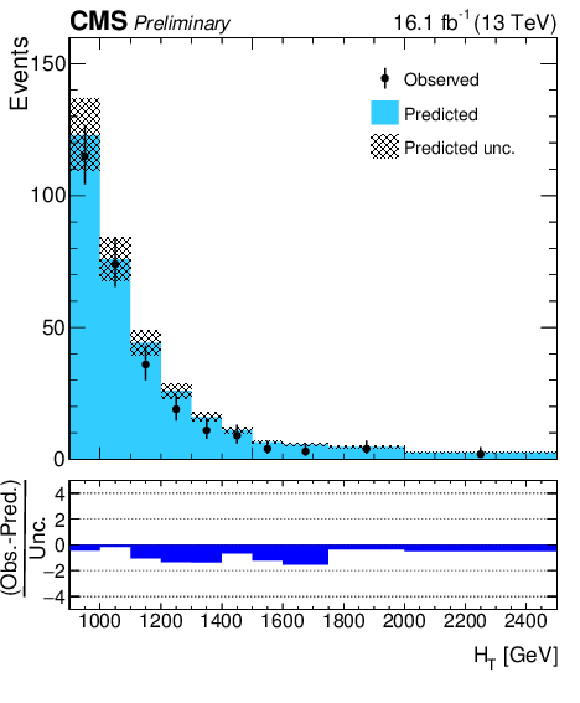
png pdf |
Figure 4-a:
The $ {H_{\mathrm {T}}} $ distribution for the observed data events (black) and the predicted background estimation (blue) for selection set 8 (QCD-enhanced). |
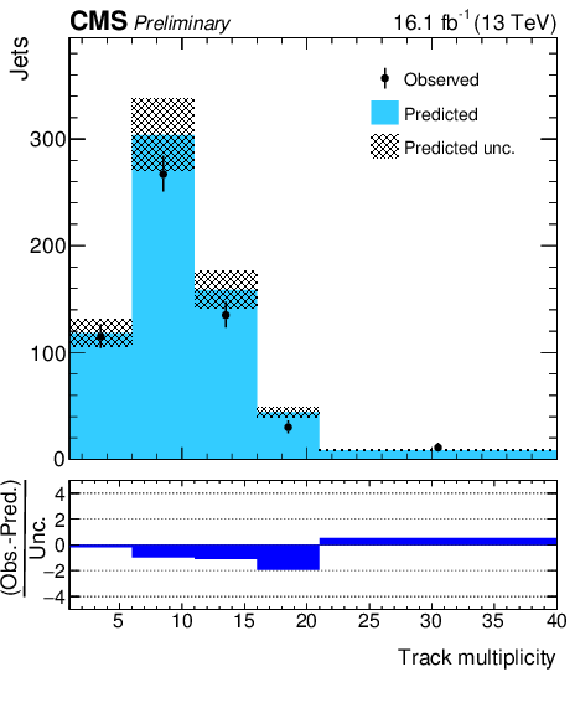
png pdf |
Figure 4-b:
The number of associated tracks distribution for the observed data events (black) and the predicted background estimation (blue) for selection set 8 (QCD-enhanced). |
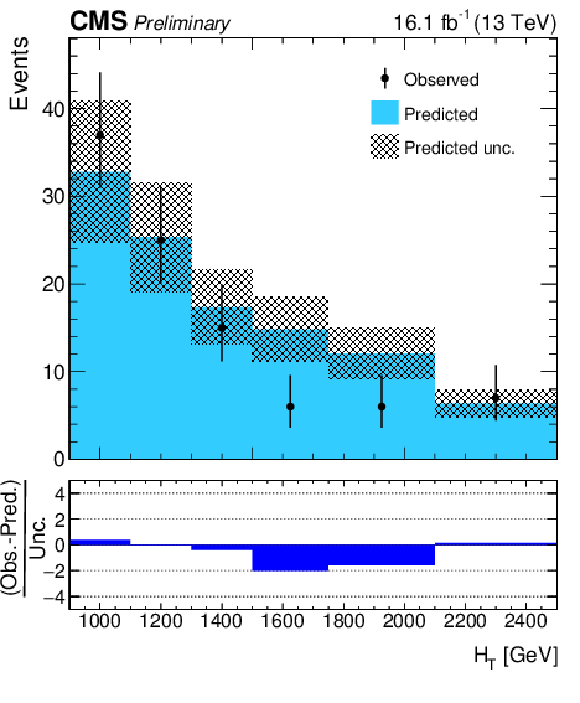
png pdf |
Figure 5-a:
The $ {H_{\mathrm {T}}} $ distribution of the observed data events (black) and the predicted background estimation (blue) for selection set 9 (QCD-enhanced). |
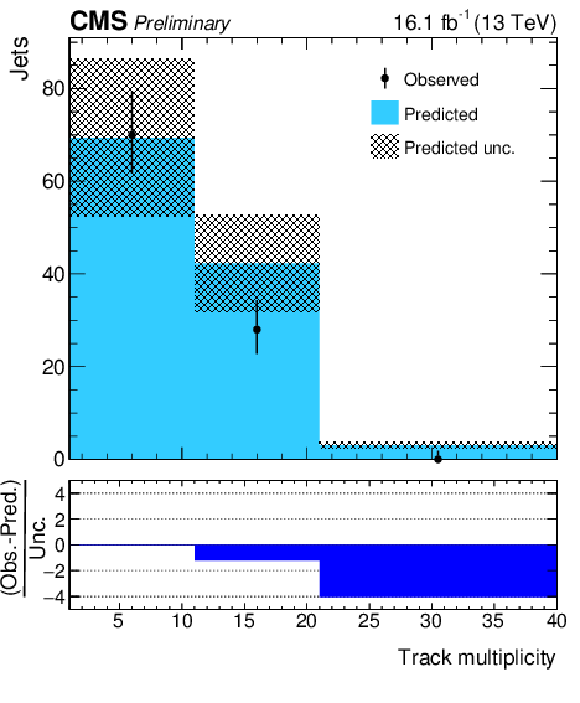
png pdf |
Figure 5-b:
The number of associated tracks distribution of the observed data events (black) and the predicted background estimation (blue) for selection set 9 (QCD-enhanced). |
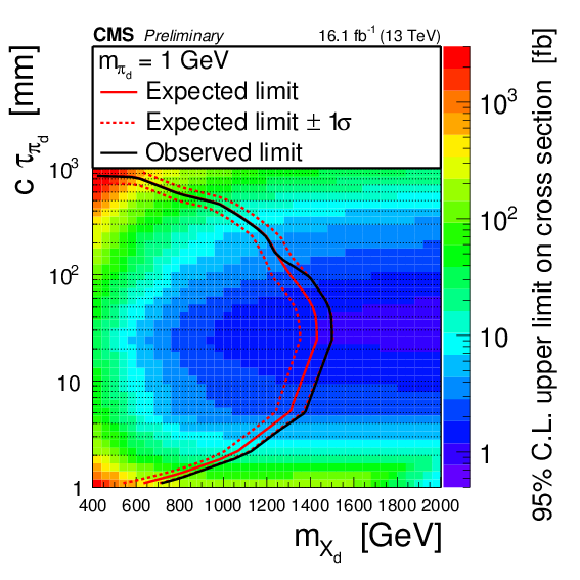
png pdf |
Figure 6-a:
Signal exclusion curves derived from theory-predicted cross sections and upper limits at 95% CL on the signal cross section for models with dark pion mass ${m_{\pi _\mathrm {d}}} = $ 1 GeV. |
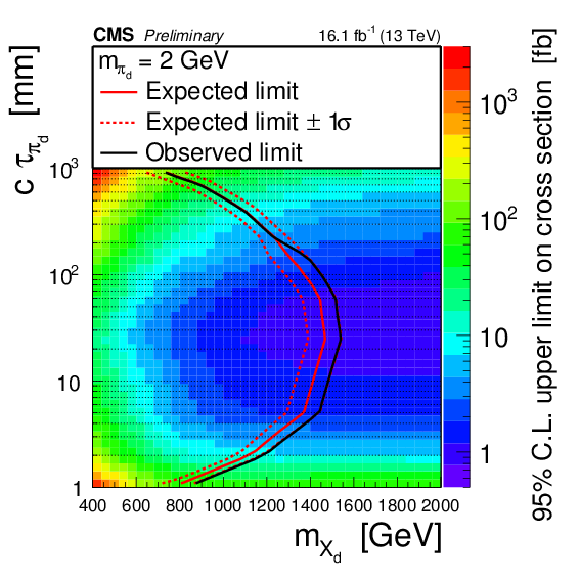
png pdf |
Figure 6-b:
Signal exclusion curves derived from theory-predicted cross sections and upper limits at 95% CL on the signal cross section for models with dark pion mass ${m_{\pi _\mathrm {d}}} = $ 2 GeV. |

png pdf |
Figure 6-c:
Signal exclusion curves derived from theory-predicted cross sections and upper limits at 95% CL on the signal cross section for models with dark pion mass ${m_{\pi _\mathrm {d}}} = $ 5 GeV. |
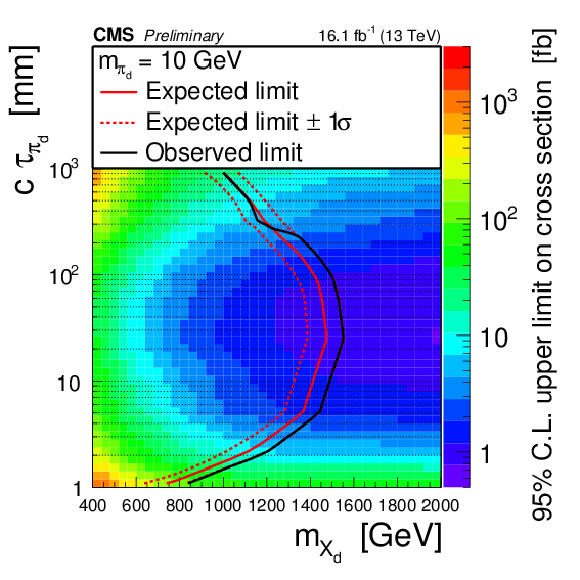
png pdf |
Figure 6-d:
Signal exclusion curves derived from theory-predicted cross sections and upper limits at 95% CL on the signal cross section for models with dark pion mass ${m_{\pi _\mathrm {d}}} = $ 10 GeV. |
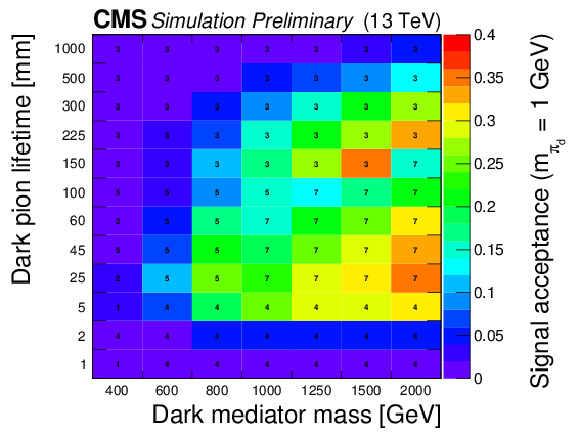
png pdf |
Figure 7-a:
2-dimensional plots of signal acceptance for dark pion mass 1 GeV. The corresponding selection set number for each model is indicated as text on the plot. |
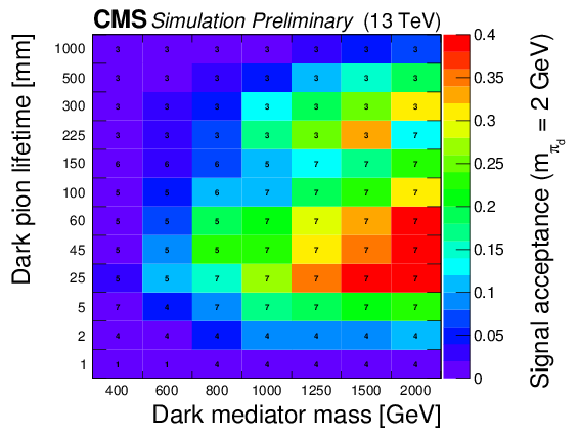
png pdf |
Figure 7-b:
2-dimensional plots of signal acceptance for dark pion mass 2 GeV. The corresponding selection set number for each model is indicated as text on the plot. |
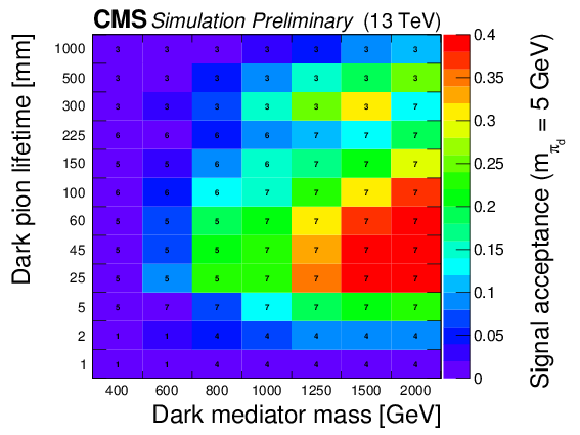
png pdf |
Figure 7-c:
2-dimensional plots of signal acceptance for dark pion mass 5 GeV. The corresponding selection set number for each model is indicated as text on the plot. |
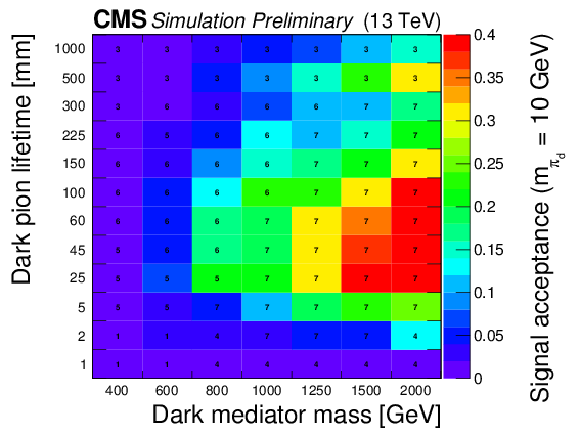
png pdf |
Figure 7-d:
2-dimensional plots of signal acceptance for dark pion mass 10 GeV. The corresponding selection set number for each model is indicated as text on the plot. |
| Tables | |

png pdf |
Table 1:
Parameters used in generating simulated signal event samples. A sample corresponding to a single model was created for each possible permutation of the values. |
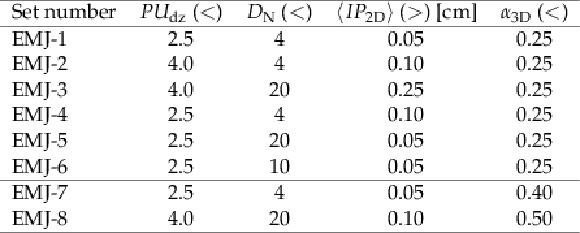
png pdf |
Table 2:
Optimized requirements (selection directions indicated in parentheses) on the variables used in the identification of emerging jets. EMJ-1 to 6 are used for the selection sets that define the signal regions, while EMJ-7 and 8 are used to define QCD-enhanced samples used for tests of the efficacy of the background estimation method. |

png pdf |
Table 3:
The seven optimized selection sets used in signal selection for this search, and the two QCD-enhanced selections (sets 8 and 9) used in tests of the efficacy of the background estimation methods. The last column is the total number of models defined in Table 1 associated to each selection set. The headers of the columns are: the minimum number of the four leading jets that pass the emerging jet selection ($n_\mathrm {em}$), the requirements on the ${p_{\mathrm {T}}}$ of the jets ($p_\mathrm {T,i}$), the scalar sum of the ${p_{\mathrm {T}}} $'s of the four leading jets (${H_{\mathrm {T}}}$), and the EMJ set described in Table 2. |

png pdf |
Table 4:
Systematic uncertainties affecting the data-driven background estimation. For the definition of the selection sets, see Table 3. |
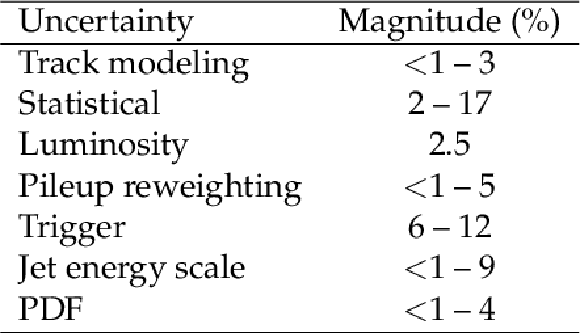
png pdf |
Table 5:
Range of systematic uncertainties on signal acceptances by source for the models in Table 1 for which a 95% CL exclusion is expected. |

png pdf |
Table 6:
Expected ($\mathrm {mean} \pm \mathrm {syst}_1 \pm \mathrm {syst}_2$) and observed event yields for each selection set. Uncertainties due to the limited number of events in the control region and statistical uncertainties in the misidentification rates are denoted "syst$_1$'', while "syst$_2$'' combines those discussed in Table 4. |
| Summary |
| This analysis presents a search for events consistent with pair production of a heavy mediator particle that decays to a light quark and a new fermion called a dark quark using data from proton-proton collisions at $\sqrt{s} = $ 13 TeV corresponding to an integrated luminosity of 16.1 fb$^{-1}$. The dark quark is assumed to be charged only under a new QCD-like dark force, and to form long-lived dark hadrons via a parton shower. The resulting emerging jets would contain charged particles that are consistent with having been created by dark hadron decays to standard model hadrons. Mediator particles with masses between 400 and 1250 GeV are excluded for dark hadron decay lengths between 5 and 225 mm. These are the first results from a dedicated search for the new particles predicted by the model described in Ref. [5,6]. |
| Additional Figures | |
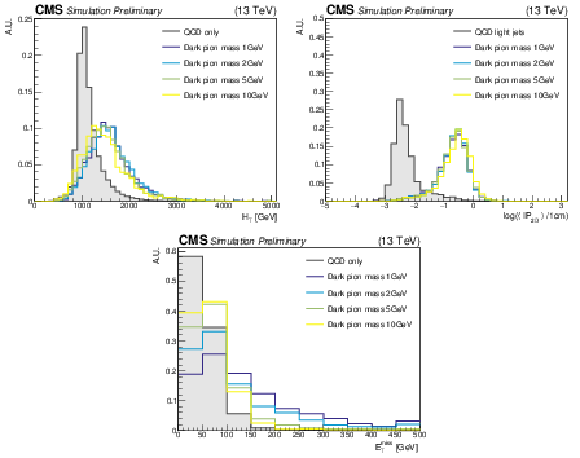
png pdf |
Additional Figure 1:
Cut variable distributions of 1 TeV dark mediator mass and 25 mm dark pion lifetime. Shown are (a) $ {H_{\mathrm {T}}} $, (b) $< IP_{\mathrm {2D}}> $, and (c) $ {E_{\mathrm {T}}^{\text {miss}}} $. |
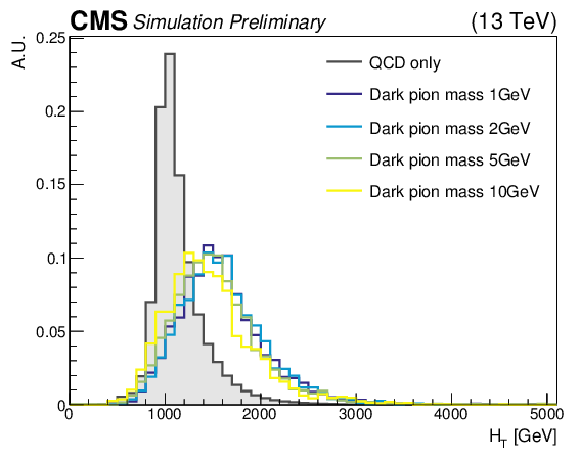
png pdf |
Additional Figure 1-a:
Cut variable distribution of 1 TeV dark mediator mass and 25 mm dark pion lifetime. Shown is $ {H_{\mathrm {T}}} $. |
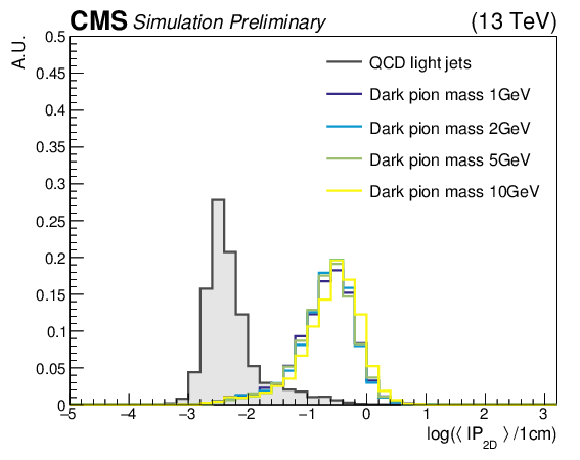
png pdf |
Additional Figure 1-b:
Cut variable distribution of 1 TeV dark mediator mass and 25 mm dark pion lifetime. Shown is $< IP_{\mathrm {2D}}> $. |
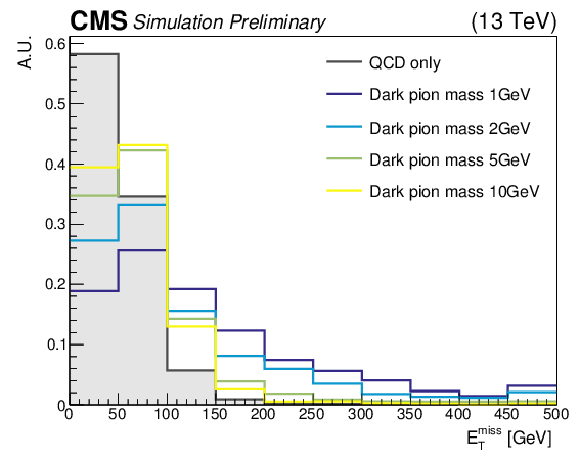
png pdf |
Additional Figure 1-c:
Cut variable distribution of 1 TeV dark mediator mass and 25 mm dark pion lifetime. Shown is $ {E_{\mathrm {T}}^{\text {miss}}} $. |

png pdf |
Additional Figure 2:
Cut variable distributions of 1 TeV dark mediator mass and 2 GeV dark pion mass. Shown are (a) $ {H_{\mathrm {T}}} $, (b) $< IP_{\mathrm {2D}}> $, and (c) $ {E_{\mathrm {T}}^{\text {miss}}} $. |
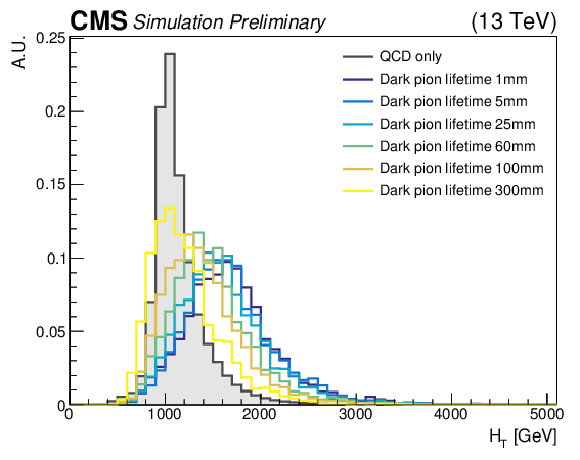
png pdf |
Additional Figure 2-a:
Cut variable distributions of 1 TeV dark mediator mass and 2 GeV dark pion mass. Shown is $ {H_{\mathrm {T}}} $. |
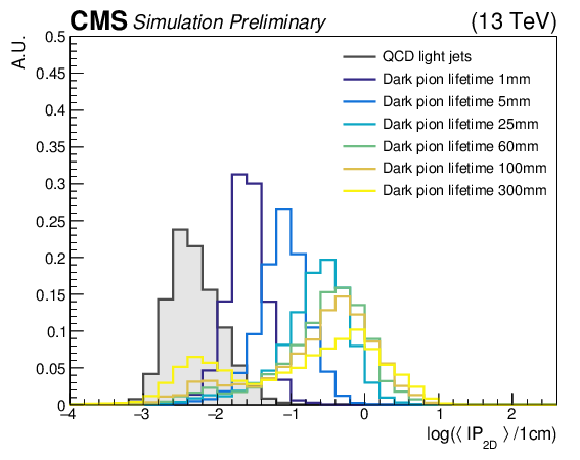
png pdf |
Additional Figure 2-b:
Cut variable distributions of 1 TeV dark mediator mass and 2 GeV dark pion mass. Shown is $< IP_{\mathrm {2D}}> $. |
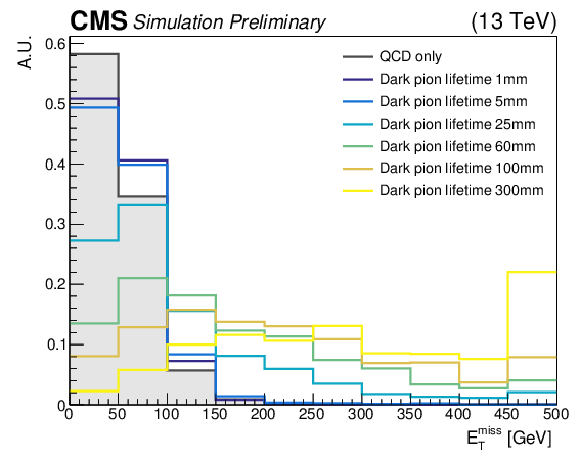
png pdf |
Additional Figure 2-c:
Cut variable distributions of 1 TeV dark mediator mass and 2 GeV dark pion mass. Shown is $ {E_{\mathrm {T}}^{\text {miss}}} $. |
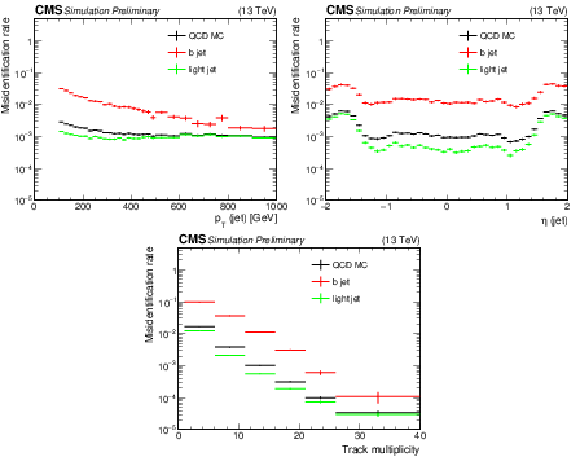
png pdf |
Additional Figure 3:
Distributions from simulation of the misidentification rate for a jet to pass the EMJ-1 criteria shown as a function of jet $ {p_{\mathrm {T}}} $ (a), $\eta $ (b) and track multiplicity (c), where the track multiplicity is calculated using tracks with $ {p_{\mathrm {T}}} > $ 1 GeV, passing highPurity cuts and our pile-up cut $PU_{\mathrm {dz}}$. The misidentification rate has a strongly dependence on track multiplicity. The misidentification rate for b jets to pass the event selection is much higher than other flavor (gluon, u, d, c, s) jets. |
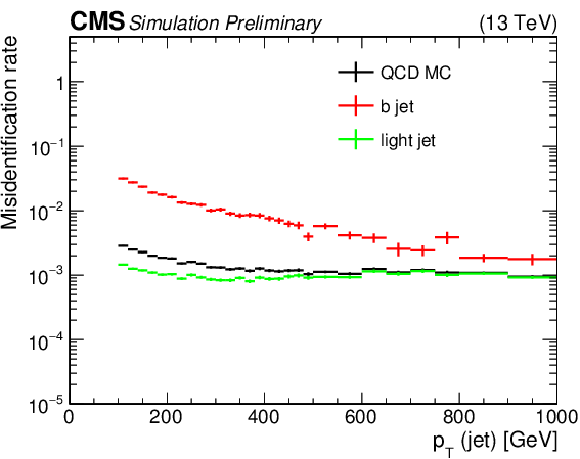
png pdf |
Additional Figure 3-a:
Distribution from simulation of the misidentification rate for a jet to pass the EMJ-1 criteria shown as a function of jet $ {p_{\mathrm {T}}} $. The misidentification rate for b jets to pass the event selection is much higher than other flavor (gluon, u, d, c, s) jets. |
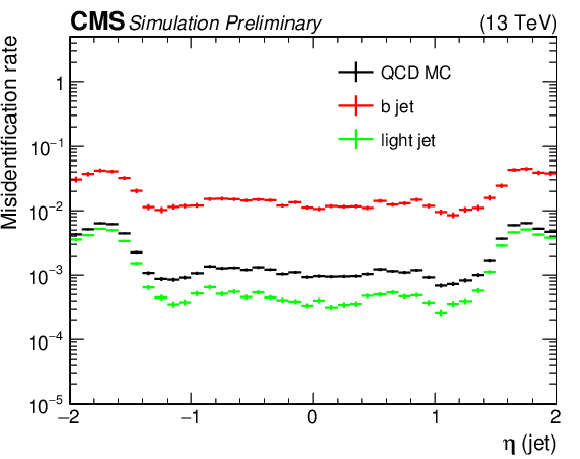
png pdf |
Additional Figure 3-b:
Distribution from simulation of the misidentification rate for a jet to pass the EMJ-1 criteria shown as a function of jet $\eta $. The misidentification rate for b jets to pass the event selection is much higher than other flavor (gluon, u, d, c, s) jets. |
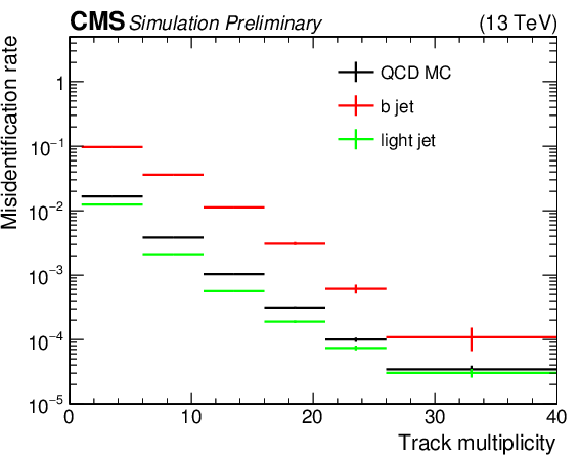
png pdf |
Additional Figure 3-c:
Distribution from simulation of the misidentification rate for a jet to pass the EMJ-1 criteria shown as a function of jet track multiplicity, where the track multiplicity is calculated using tracks with $ {p_{\mathrm {T}}} > $ 1 GeV, passing highPurity cuts and our pile-up cut $PU_{\mathrm {dz}}$. The misidentification rate has a strongly dependence on track multiplicity. The misidentification rate for b jets to pass the event selection is much higher than other flavor (gluon, u, d, c, s) jets. |

png pdf |
Additional Figure 4:
Distributions of misidentification rate (left) and b quark fraction (right) from the b-depleted and b-enhanced control samples of $ {\gamma} $+jet simulation in the closure test region (selection set 8). In addition to the fitted results, the right plot shows also the truth b quark fraction distributions for comparison. Only statistical uncertainties are included in the plots. |
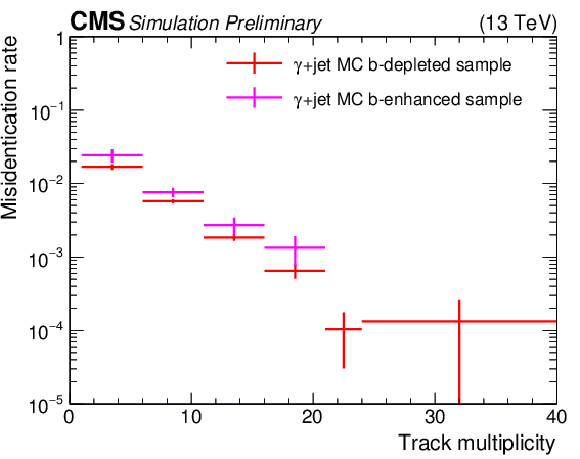
png pdf |
Additional Figure 4-a:
Distribution of the misidentification rate from the b-depleted and b-enhanced control samples of $ {\gamma} $+jet simulation in the closure test region (selection set 8). |
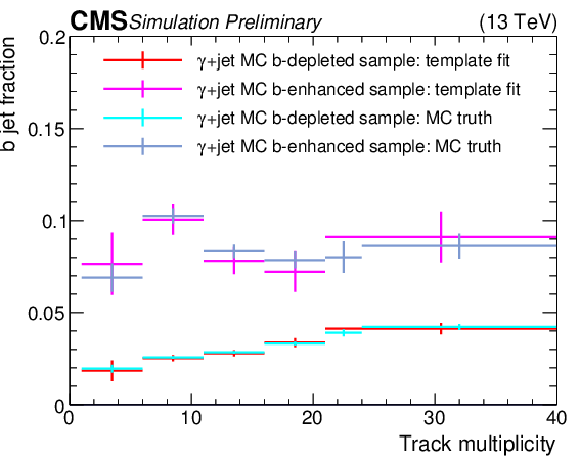
png pdf |
Additional Figure 4-b:
Distribution of the b quark fraction from the b-depleted and b-enhanced control samples of $ {\gamma} $+jet simulation in the closure test region (selection set 8). In addition to the fitted results, the plot shows also the truth b quark fraction distributions for comparison. |
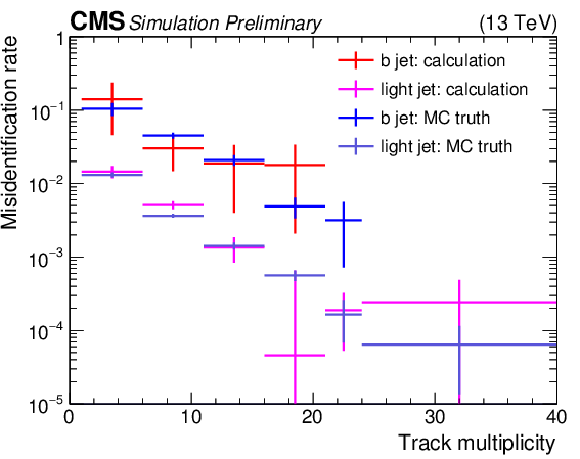
png pdf |
Additional Figure 5:
Comparisons of the misidentification rates of q quark and light-flavor jets, using the $ {\gamma} $+jet MC samples in the closure test region (selection set 8), between the cases when uses the truth ratio of jet flavors and when uses the calculated ratio by the method introduced in this analysis. |

png pdf |
Additional Figure 6:
Results from fitting b tagging discriminator distribution using templates of light jets and b jets from QCD MC events in the closure test region (selection set 8): the fractions of b quark jets in the 0-tag events (left) and 1-tag events (right). In both of the plots, the black points represent the b tagging discriminator distribution of the entire sample, the green distribution is the template of light-flavor jets, the red one is the template of b quark jets, and the blue one is the fitted results. The bottom inset shows the difference between data and fitted results, divided by the statistical uncertainty. |

png pdf |
Additional Figure 6-a:
Results from fitting b tagging discriminator distribution using templates of light jets and b jets from QCD MC events in the closure test region (selection set 8): the fractions of b quark jets in the 0-tag events. The black points represent the b tagging discriminator distribution of the entire sample, the green distribution is the template of light-flavor jets, the red one is the template of b quark jets, and the blue one is the fitted results. The bottom inset shows the difference between data and fitted results, divided by the statistical uncertainty. |
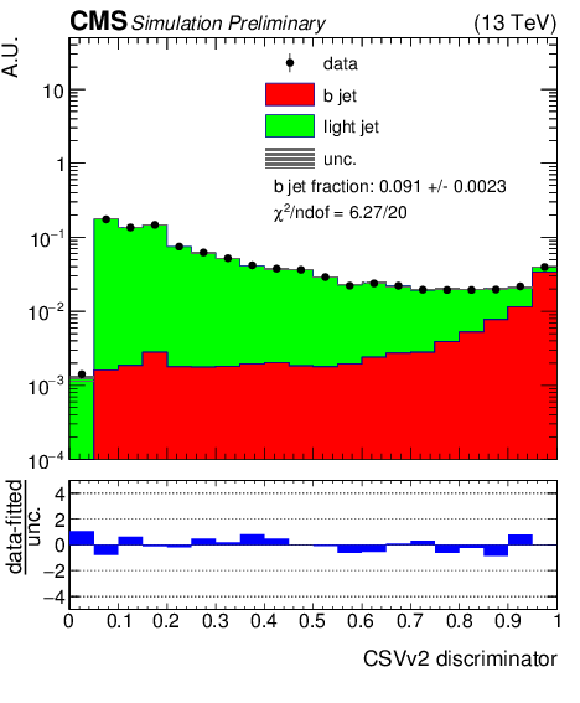
png pdf |
Additional Figure 6-b:
Results from fitting b tagging discriminator distribution using templates of light jets and b jets from QCD MC events in the closure test region (selection set 8): the fractions of b quark jets in the 1-tag events. The black points represent the b tagging discriminator distribution of the entire sample, the green distribution is the template of light-flavor jets, the red one is the template of b quark jets, and the blue one is the fitted results. The bottom inset shows the difference between data and fitted results, divided by the statistical uncertainty. |
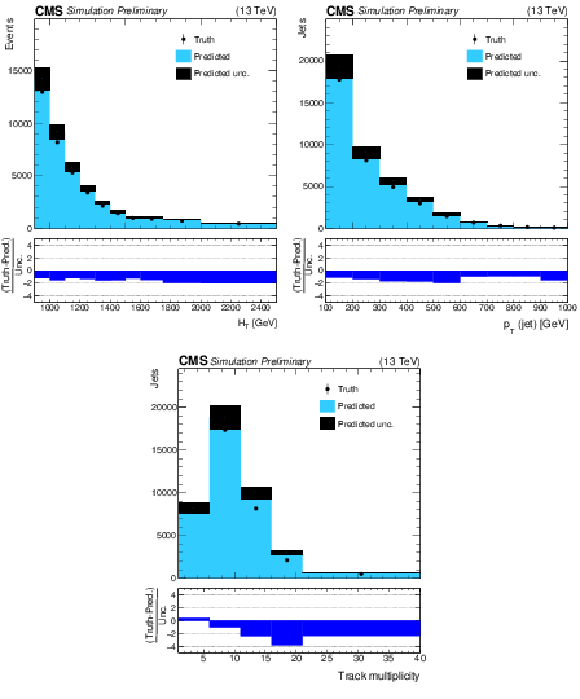
png pdf |
Additional Figure 7:
Closure Test results on 1-tag QCD MC events, i.e., events with one jet passing emerging jet selection. Distributions shown are (a) $ {H_{\mathrm {T}}} $, (b) $ {p_{\mathrm {T}}} $, and (c) track multiplicity. In all these plots, the black ones are the truth distributions, while the blue histograms are predicted. The uncertainty of the predicted distribution is calculated using the toy MC method. |

png pdf |
Additional Figure 7-a:
Closure Test results on 1-tag QCD MC events, i.e., events with one jet passing emerging jet selection. Distribution shown is $ {H_{\mathrm {T}}} $. The black ones are the truth distributions, while the blue histograms are predicted. The uncertainty of the predicted distribution is calculated using the toy MC method. |
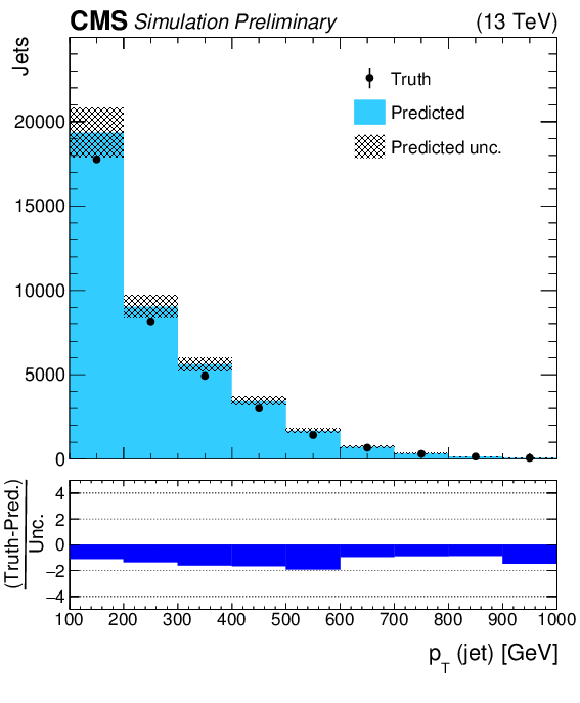
png pdf |
Additional Figure 7-b:
Closure Test results on 1-tag QCD MC events, i.e., events with one jet passing emerging jet selection. Distribution shown is $ {p_{\mathrm {T}}} $. The black ones are the truth distributions, while the blue histograms are predicted. The uncertainty of the predicted distribution is calculated using the toy MC method. |
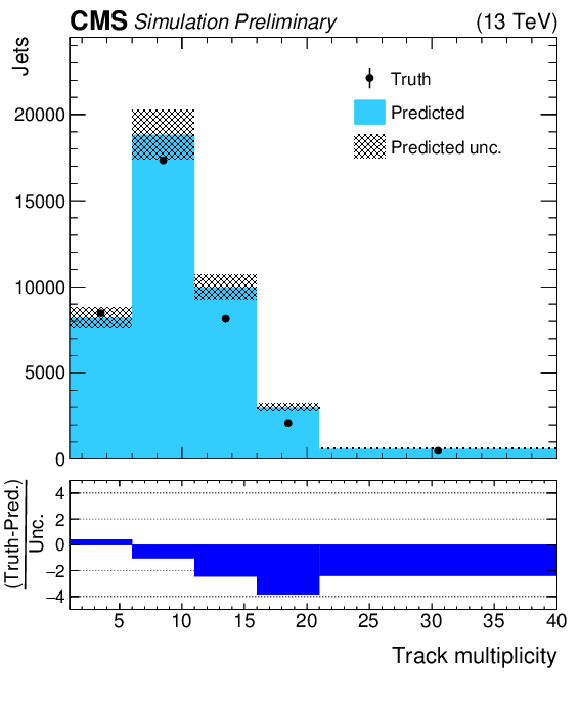
png pdf |
Additional Figure 7-c:
Closure Test results on 1-tag QCD MC events, i.e., events with one jet passing emerging jet selection. Distribution shown is track multiplicity. The black ones are the truth distributions, while the blue histograms are predicted. The uncertainty of the predicted distribution is calculated using the toy MC method. |
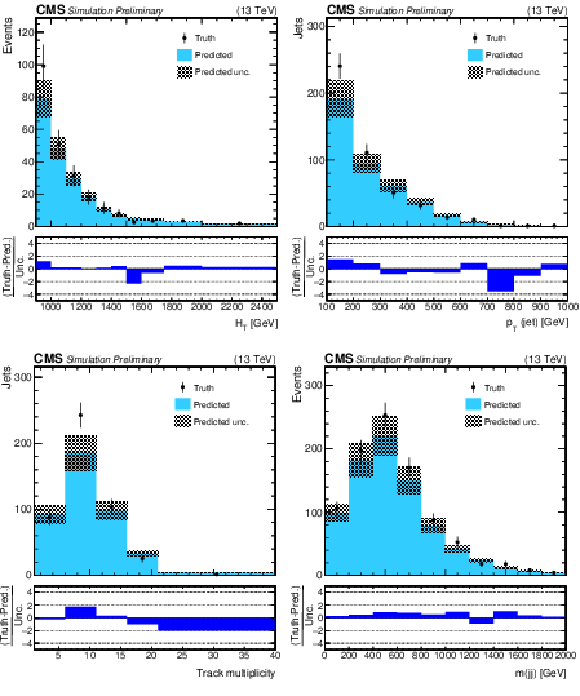
png pdf |
Additional Figure 8:
Closure Test results on 2-tag QCD MC events, i.e., events with two jets passing emerging jet selection. Distributions shown are (a) $ {H_{\mathrm {T}}} $, (b) $ {p_{\mathrm {T}}} $, (c) track multiplicity, and (d) the invariant mass of one `emerging' jet and one Standard Model jet. In all these plots, the black points are the truth distributions, while the blue histograms are predicted. The uncertainty of the predicted distribution is calculated using the toy MC method. |

png pdf |
Additional Figure 8-a:
Closure Test results on 2-tag QCD MC events, i.e., events with two jets passing emerging jet selection. Distributions shown is $ {H_{\mathrm {T}}} $. The black points are the truth distributions, while the blue histograms are predicted. The uncertainty of the predicted distribution is calculated using the toy MC method. |

png pdf |
Additional Figure 8-b:
Closure Test results on 2-tag QCD MC events, i.e., events with two jets passing emerging jet selection. Distributions shown is $ {p_{\mathrm {T}}} $. The black points are the truth distributions, while the blue histograms are predicted. The uncertainty of the predicted distribution is calculated using the toy MC method. |
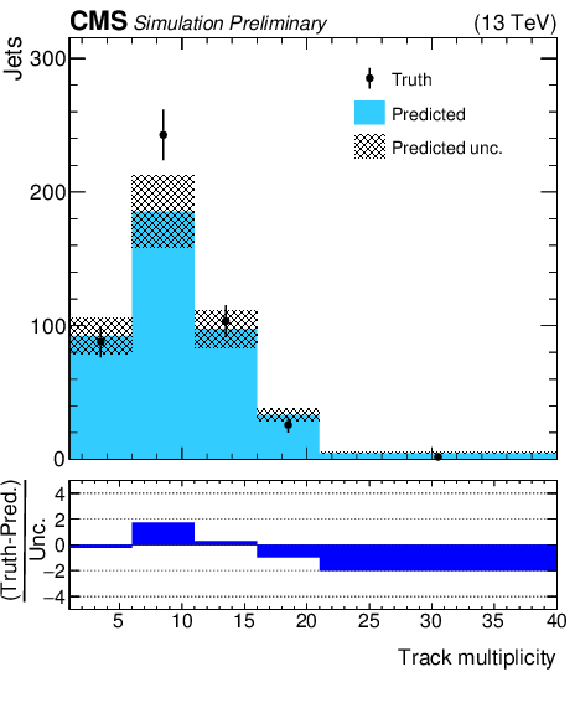
png pdf |
Additional Figure 8-c:
Closure Test results on 2-tag QCD MC events, i.e., events with two jets passing emerging jet selection. Distributions shown is track multiplicity. The black points are the truth distributions, while the blue histograms are predicted. The uncertainty of the predicted distribution is calculated using the toy MC method. |
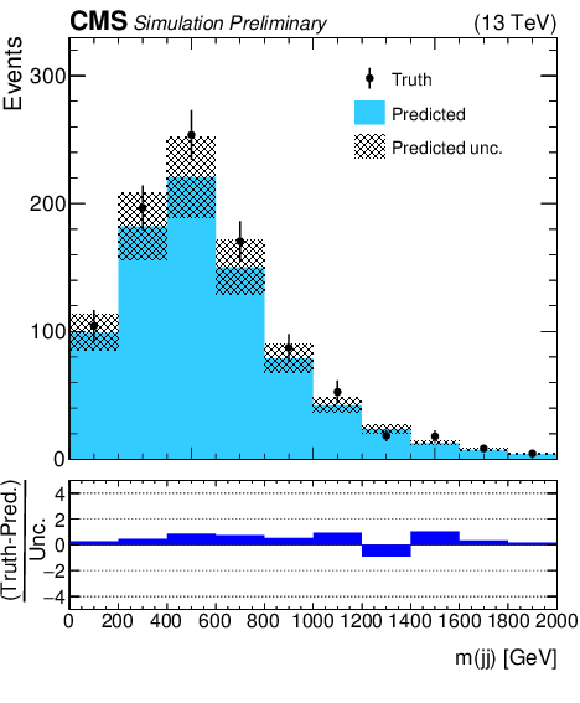
png pdf |
Additional Figure 8-d:
Closure Test results on 2-tag QCD MC events, i.e., events with two jets passing emerging jet selection. Distributions shown is the invariant mass of one `emerging' jet and one Standard Model jet. The black points are the truth distributions, while the blue histograms are predicted. The uncertainty of the predicted distribution is calculated using the toy MC method. |
| References | ||||
| 1 | G. Bertone, D. Hooper, and J. Silk | Particle dark matter: evidence, candidates and constraints | J. Phys. Rep. 405 (2005) 279 | hep-ph/0404175 |
| 2 | K. Petraki and R. Volkas | Review of asymmetric dark matter | Int. J. Mod. Phys. A 28 (2013) 1330028 | 1305.4939 |
| 3 | K. Zurek | Asymmetric dark matter: theories, signatures, and constraints | Phys. Rep. 537 (2014) 91 | 1308.0338 |
| 4 | Planck Collaboration | Planck 2015 results - XIII. cosmological parameters | A\&A 594 (2016) A13 | 1502.01589 |
| 5 | B. Yang and P. Schwaller | Scale of dark QCD | PRD 89 (2014) 063522 | 1306.4676 |
| 6 | P. Schwaller, D. Stolarski, and A. Weiler | Emerging jets | JHEP 5 (2015) 59 | 1502.05409 |
| 7 | J. Brod et al. | Stealth QCD-like strong interactions and the $ t\overline{t} $ asymmetry | PRD 91 (2015) 095009 | 1407.8188 |
| 8 | P. Agrawal, M. Blanke, and K. Gemmler | Flavored dark matter beyond Minimal Flavor Violation | JHEP 10 (2014) 72 | 1405.6709 |
| 9 | L. Calibbi, A. Crivellin, and B. Zald\'\ivar | Flavor portal to dark matter | PRD 92 (2015) 016004 | 1501.07268 |
| 10 | CMS Collaboration | The CMS experiment at the CERN LHC | JINST 3 (2008) S08004 | CMS-00-001 |
| 11 | CMS Collaboration | Description and performance of track and primary-vertex reconstruction with the CMS tracker | JINST 9 (2014) P10009 | CMS-TRK-11-001 1405.6569 |
| 12 | K. Rose | Deterministic annealing for clustering, compression, classification, regression, and related optimization problems | in Proceedings of the IEEE, p. 2210 1998 | |
| 13 | R. Fruhwirth, W. Waltenberger, and P. Vanlaer | Adaptive vertex fitting | JPG 34 (2007) N343 | |
| 14 | M. Cacciari, G. P. Salam, and G. Soyez | The anti-$ k_t $ jet clustering algorithm | JHEP 04 (2008) 063 | 0802.1189 |
| 15 | M. Cacciari, G. P. Salam, and G. Soyez | Fastjet user manual | EPJC 72 (2012) 1896 | 1111.6097 |
| 16 | CMS Collaboration | Particle-flow reconstruction and global event description with the CMS detector | JINST 12 (2017) P10003 | CMS-PRF-14-001 1706.04965 |
| 17 | CMS Collaboration | Jet energy scale and resolution in the CMS experiment in pp collisions at 8 TeV | JINST 12 (2017) P02014 | CMS-JME-13-004 1607.03663 |
| 18 | J. Alwall et al. | The automated computation of tree-level and next-to-leading order differential cross sections, and their matching to parton shower simulations | JHEP 07 (2014) 079 | 1405.0301 |
| 19 | T. Sjostrand et al. | An Introduction to PYTHIA 8.2 | CPC 191 (2015) 159--177 | 1410.3012 |
| 20 | C. Borschensky et al. | Squark and gluino production cross sections in pp collisions at $ \sqrt{s} = $ 13 , 14, 33 and 100 TeV | EPJC 74 (2014) 3174 | 1407.5066 |
| 21 | GEANT4 Collaboration | $ GEANT4-a $ simulation toolkit | Nucl. Instrum. Meth A 506 (2003) 250 | |
| 22 | J. Allison et al. | Geant4 developments and applications | IEEE Trans. Nucl. Sci 53 (2006) 270 | |
| 23 | CMS Collaboration | Search for new long-lived particles at $ \sqrt{s} = $ 13 TeV | PLB 780 (2018) 432 | CMS-EXO-16-003 1711.09120 |
| 24 | CMS Collaboration | Identification of heavy-flavour jets with the cms detector in pp collisions at 13 TeV | Submitted to \it JINST | CMS-BTV-16-002 1712.07158 |
| 25 | CMS Collaboration | Cms luminosity measurements for the 2016 data taking period | CMS-PAS-LUM-17-001 | CMS-PAS-LUM-17-001 |
| 26 | R. D. Ball et al. | Parton distributions with lhc data | Nuclear Physics B 867 (2013) 244 -- 289 | |
| 27 | T. Junk | Confidence level computation for combining searches with small statistics | NIMA434 (1999) 435--443 | hep-ex/9902006 |
| 28 | A. L. Read | Presentation of search results: The CL(s) technique | JPG28 (2002) 2693 | |
| 29 | ATLAS and CMS Collaborations, The LHC Higgs Combination Group | Procedure for the LHC Higgs boson search combination in Summer 2011 | CMS-NOTE-2011-005 | |

|
Compact Muon Solenoid LHC, CERN |

|

|

|

|

|

|